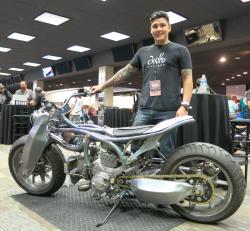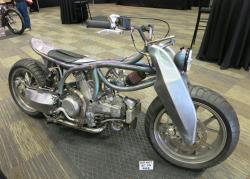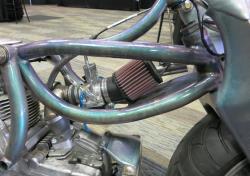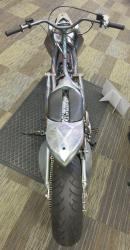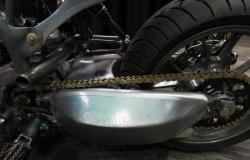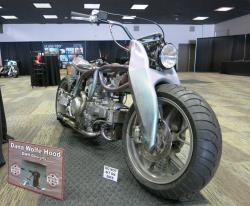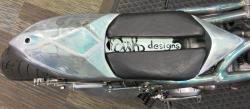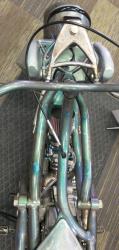Dana Wolfe Hood of DWH Designs Creates a Dynamic Custom Ducati Motorcycle
- 12 Oct 2017
Hood graduated Cum Laude from the Colorado State University School of Business with a dual concentration in Marketing and Management. Since his schedule was not quite chock-full, he minored in Journalism and Media, Fine Art, and Anthropology. Hood created his company, DWH Designs, in a valiant attempt to synthesize all of his interests. As he puts it, “art, industrial design, mechanical engineering, and fabrication are the passions that worked, with only music falling to the wayside.” A look through the DWH Designs website will give you some indication of how well that convergence has come to fruition. K&N caught up with Hood and his fantastic Ducati-based custom at the Artistry in Iron invitational custom bike show at the Las Vegas Bikefest. The build stood out as one of the most unique and visionary creations at the prestigious event. It may have been the K&N filter that is prominently featured on the build that first caught our eye, but the skeletal chassis bookended by massive front and rear suspension elements demand careful study. Every sinew of Hood’s handiwork exudes the builder’s artistic bent.
Dana Wolfe Hood on his Ducati Custom: I think the bike needs a pretty decent explanation to appreciate it. All of the aspects were well thought out and actually built for a purpose. A lot of people think that it was just built from a design perspective, and it was quite the opposite. Form definitely came after function, though I knew I wanted something low and angry with flowing lines and a knife-like front end. First off, this bike was built to tear up the streets and be ridden hard. Yes, it is a "show" or concept bike, but I designed the geometry and painted and fabricated it so it could be ridden fast on the road. It has a 2.5-gallon tank, the seat is comfortable (if you are used to dirt bikes), and the controls are simple. The exhaust is actually perfect equal lengths, it has good ground clearance, it has "effective" front and rear fenders from how I designed it, and it has high-performance front and rear suspension.
Keep in mind that the frame is lighter than a stock monster frame, the front end is several pounds lighter than an Ohlins front end, and the swingarm is about the same weight as a stock Ducati swingarm, but doubles as a tank. To counteract the effects of increasing the unsprung weight, I decreased the leverage on the shock damper drastically. The sprung weight was reduced and the leverage decreased so much so that a mountain bike shock is used for the front suspension. As an added benefit, the shock location for the front and rear suspension are in the same location so adjustments can be done on the fly or at a quick stop with one hand. It is also beneficial to run the front and rear shocks that I chose (Fox Racing Shox Float) as they can be completely rebuilt in about 5 minutes, without nitrogen, and have infinite adjustability in terms of valving and spring rate via air pressure.
You only need a few inches of suspension travel for street riding anyways and I've tuned the shocks so they have a fairly progressive rate. I further increased the progressiveness of the rear shock mechanically by creating a progressive link. The link pushes the shock from both ends and drastically changes the spring curve on the rear shock. That paired with the ability to change the volumes of the air cans in the shocks allows for infinite spring curve adjustability.
The motor is actually comprised of about 6 different Ducati motors. The bottom end is from a 2000 M750. It has a bunch of random M800, 750SS, and M600 pieces in there, too. It has M800 cylinders with FBF 88mm high compression pistons. It's all topped off with 2006 M620 heads as they have a better cam and valve timing. The intake is a stainless 1 into 2 with a single custom built Lectron carb and K&N filter feeding the bike. The exhaust is an equal length stainless system I designed. So as far as the design goes, I suppose I approach motorcycle design from a minimalist's perspective because of a couple things. First, I think that the mechanics of the motor, suspension, and chassis are the most beautiful parts of a vehicle. I dislike when people cover up all of the structural and moving parts. Furthermore, that's just additional, unneeded weight (though if it relates to aerodynamics then that's completely different).
Finally, I did look at the bike from a design perspective after I knew what I wanted to accomplish. I really always like some of the crazy girders that custom builders like Confederate, Cherry's Company, and Speed Shop Designs created. I knew that I wanted to put the fuel in the swingarm, but needed to balance it out visually with something up front. So that, combined with the need to add some additional front weight and rigidity, led to the visual weight of the front end. Plus, it added balance, repetition, and another surface that I could show off some engraving.
The hardest aspect of the build was actually multiple things. The first was timeline. I originally was building the bike for the AIMExpo show for this year. I randomly reached out to Revival about their Handbuilt show this past April and then they wanted the Ducati to be in their show. At the time, it was just a motor and a couple of bent tubes in a jig. So, I built the bike in 3 months, after work and on weekends. Then after that show, I shifted my attention to my personal bike that I had been building. Of course, I had to reach out to Artistry in Iron, because it was a goal of mine to show in it. Somehow, I was asked to come. So I rebuilt and redesigned the bike in about a month, all after work and on weekends, because it didn't turn out exactly how I wanted at the Austin Handbuilt show. The paint was actually drying on the trip to the show, so no time to buff or polish.
Probably the most difficult thing was the geometry and steering linkage. I designed about 7 different linkages throughout both iterations of the bike. They all worked and were designed around other proven steering linkages in trophy trucks and motorcycles, but they created feedback throughout the suspension travel that I disliked. So, after the Handbuilt Show, I redesigned the entire front end of the motorcycle. That led to the current linkage that is the best, but I'm probably going to beef up the upper linkage even further to reduce flex. All the metal shaping was insanely difficult, too. All the metal was shaped with heat, a hammer, and a sandbag. All of the tubes were bent with a fairly basic tube bender - no machining – all handmade, literally. I'm saving up for an English Wheel and a JD2 bender, and maybe eventually a Bridgeport. Finally, I chose K&N because they are the benchmark when it comes to air filters. The Ducati currently has a K&N air filter and a fuel pump with a fuel filter. I've always had good experiences with K&N and they have been installed in almost every vehicle I've ever owned. It doesn't hurt that they're a US company, and supporting US businesses is something I definitely value. 99.9% of the Ducati was made in USA, Germany, or Italy. | ||||||||
| | ||||||||
| ||||||||
| | ||||||||

